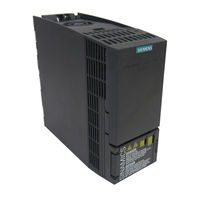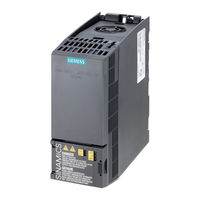Siemens SINAMICS G120C PN Manuals
Manuals and User Guides for Siemens SINAMICS G120C PN. We have 2 Siemens SINAMICS G120C PN manuals available for free PDF download: Operating Instructions Manual
Siemens SINAMICS G120C PN Operating Instructions Manual (478 pages)
Low voltage converters
Table of Contents
-
Introduction25
-
Description29
-
Intended Use29
-
Openssl29
-
Installing41
-
Cables44
-
IT System69
-
Installing GSDML114
-
Commissioning121
-
Overview127
-
Expert135
-
Expert150
-
Automatic Upload168
-
Write Protection177
-
Digital Inputs191
-
Digital Outputs194
-
Analog Input196
-
Analog Output200
-
Telegrams214
-
Examples228
-
Jogging242
-
Motor Standard253
-
Unit System253
-
Password260
-
Acceptance Test271
-
Setpoints272
-
Overview272
-
Overview281
-
Invert Setpoint283
-
Speed Limitation287
-
Motor Control301
-
U/F Control302
-
DC Braking328
-
Compound Braking333
-
Dynamic Braking334
-
Spare Parts405
-
Overview405
-
Overview412
-
Technical Data423
-
Accessories442
-
Line Reactor442
-
Line Filter444
-
Output Reactor445
-
Sine-Wave Filter446
-
Braking Resistor448
-
Appendix451
-
Fundamentals463
Advertisement
Siemens SINAMICS G120C PN Operating Instructions Manual (470 pages)
SINAMICS G120C series Low voltage converter Built-in units with frame sizes AA - F
Brand: Siemens
|
Category: Media Converter
|
Size: 12.31 MB
Table of Contents
-
4 Installing
41-
Cables43
-
IT System67
-
Installing GSDML107
-
5 Commissioning
115 -
-
Digital Inputs163
-
Digital Outputs165
-
Analog Input166
-
Analog Output170
-
Telegrams180
-
Jogging201
-
Setpoints235
-
Overview235
-
Invert Setpoint244
-
Speed Limitation247
-
Motor Control258
-
V/F Control259
-
DC Braking285
-
Compound Braking288
-
Dynamic Braking290
-
-
Memory Cards322
-
Write Protection340
-
-
Spare Parts383
-
-
Accessories422
-
Line Reactor422
-
Line Filter423
-
Output Reactor424
-
Sine-Wave Filter425
-
Braking Resistor427
-
Appendix
429-
Fundamentals447
-
Product Support462
-
Index463
Advertisement
Related Products
- Siemens SINAMICS G12
- Siemens SINAMICS G120C DP
- Siemens SINAMICS G120XA
- Siemens SINAMICS G120X
- Siemens SINAMICS G120 PM240P-2
- Siemens SINAMICS G110D 6SL3511-0PE17-5AM0
- Siemens SINAMICS G110D 6SL3511-0PE21-5AM0
- Siemens SINAMICS G110D 6SL3511-0PE25-5AM0
- Siemens SINAMICS G110D 6SL3511-0PE24-0AM0
- Siemens SINAMICS G110D 6SL3511-0PE23-0AM0

